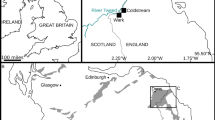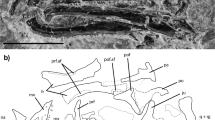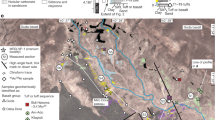Abstract
Luo1 suggests that the vertebrate fauna from the Yixian Formation (Liaoning Province, China) shows that this region of eastern Asia was a refugium, in which several typically Late Jurassic lineages (compsognathid theropod dinosaurs, ‘rhamphorhynchoid’ pterosaurs, primitive mammals) survived into the Early Cretaceous1 (Fig. 1). Data from slightly older sediments in the Japanese Early Cretaceous, however, suggest that the faunal composition of this region can only be partly explained by the concept of a refugium.

Data on Camptosaurus and Echinodon are from ref. 13. Arrows, lineage extends beyond the time range shown here; solid bars, first and last occurrences. Al, Albian; Ap, Aptian; Ba, Bathonian; Be, Berriasian; Br, Barremian; Ca, Callovian; Ha, Hauterivian; Ki, Kimmeridgian; Ox, Oxfordian; Ti, Tithonian; Va, Valanginian.
Similar content being viewed by others
Main
The Kuwajima Formation of Ishikawa Prefecture, central Japan, is yielding an important Early Cretaceous vertebrate fauna. This unit is a lateral equivalent of the Okurodani Formation that outcrops in neighbouring Gifu Prefecture2. Stratigraphic, biostratigraphic and radiometric data show that the Okurodani Formation is basal Cretaceous (Valanginian or Hauterivian) in age3. The Kuwajima Formation has yielded more than one hundred isolated teeth of a new genus of tritylodontid synapsid4. Before these discoveries, tritylodontids were thought to have become extinct sometime in the Middle or early Late Jurassic, as the youngest-known tritylodontid (Bienotheroides) was recovered from late Middle Jurassic deposits. This discovery supports the concept of an East Asian refugium, but other evidence suggests that different factors may have had an equally strong influence on faunal composition.
A theropod dinosaur referable to the unnamed clade Oviraptorosauria + Therizinosauroidea5 has also been found in the tritylodontid locality. This clade is best known from the Late Cretaceous of mainland Asia, although several taxa referable to this clade are known from the late Early Cretaceous of Liaoning (Beipiaosaurus6 and Caudipteryx7), and possibly from the Early Jurassic of Yunnan Province, China8. The Japanese material, consisting of a single manual ungual ( Fig. 2) with a pronounced posterodorsal lip (a feature synapomorphic of this group of theropods5), is one of the earliest representatives of this group. The Itsuki Formation of Fukui Prefecture, a lateral equivalent of the Okurodani and Kuwajima Formations2, has produced an isolated tyrannosaurid tooth, identifiable by its D-shaped cross-section — a synapomorphy of tyrannosaurids9.
Note the prominent lip posterodorsal to the articular surface of the ungual, a synapomorphy of the clade Oviraptorosauria + Therizinosauroidea5. Scale bar, 5 mm.
These Japanese discoveries, combined with the presence of late Early Cretaceous taxa in the Yixian Formation (such as the ornithischian dinosaur Psittacosaurus 10), suggest that several dinosaur clades (such as tyrannosaurids and psittacosaurids) may have originated and diversified in eastern Asia while a number of other lineages (tritylodontid synapsids, compsognathid dinosaurs and ‘rhamphorhynchoid’ pterosaurs) persisted in this region. Moreover, the presence of hypsilophodontid and iguanodontid ornithopod dinosaurs in the Japanese Early Cretaceous11 suggests faunal connections with western Asia and Europe. The historical biogeography of this region appears to be much more complex than was thought previously.
Alternatively, the so-called relict taxa in eastern Asia may indicate that faunal turnover at the Jurassic–Cretaceous boundary was not as marked as has been suggested12. The presence of camptosaurid (Camptosaurus ) and heterodontosaurid (Echinodon) ornithopods in European Early Cretaceous faunas13 indicates faunal similarities to the Late Jurassic Morrison Formation of North America. The presence of ‘Late Jurassic’ taxa in eastern Asia may simply represent another example of this more gradual Jurassic–Cretaceous faunal transition ( Fig. 1), although more evidence is needed to distinguish between these alternatives.
References
Luo, Z. Nature 400, 23–25 ( 1999).
Maeda, S. J. Collect. Arts Sci. Chiba Univ. 3, 369– 426 (1961).
Evans, S. E. et al. New Mexico Mus. Nat. Hist. Sci. Bull. 14, 183–186 (1998).
Setoguchi, T., Matsuoka, H. & Matsuda, M. in Proc. 7th Annu. Meet. Chinese Soc. Vert. Paleontol. (eds Wang, Y.-Q & Deng, T.) 117–124 (China Ocean, Beijing, 1999).
Makovicky, P. J. & Sues, H.-D Am. Mus. Novitates 3240, 1–27 ( 1998).
Xu, X., Tang, Z.-L & Wang, X.-L Nature 399, 350– 354 (1999).
Sereno, P. C. Science 284, 2137–2147 ( 1999).
Zhao, X.-J & Xu, X. Nature 394, 234 –235 (1998).
Manabe, M. J. Paleontol. 73, 1176–1178 (1999).
Xu, X. & Wang, X.-L Vertebrata PalAsiatica 36, 147–158 (1998).
Manabe, M. & Hasegawa, Y. in 6th Symp. Mesozoic Terrest. Ecosyst. Biotas (eds Sun, A.-L & Wang, Y.-Q.) 179 (China Ocean, 1995).
Bakker, R. T. Nature 274, 661–663 ( 1978).
Norman, D. B. & Barrett, P. M. Spec. Pap. Palaeontol. (in the press).
Author information
Authors and Affiliations
Corresponding author
Rights and permissions
About this article
Cite this article
Manabe, M., Barrett, P. & Isaji, S. A refugium for relicts?. Nature 404, 953 (2000). https://doi.org/10.1038/35010199
Issue Date:
DOI: https://doi.org/10.1038/35010199
This article is cited by
-
Study on the Jehol Biota: Recent advances and future prospects
Science China Earth Sciences (2020)
-
A new Middle Jurassic diplodocoid suggests an earlier dispersal and diversification of sauropod dinosaurs
Nature Communications (2018)
-
Vertebrate diversity of the Jehol Biota as compared with other lagerstätten
Science China Earth Sciences (2010)
-
An exceptionally preserved Lower Cretaceous ecosystem
Nature (2003)
Comments
By submitting a comment you agree to abide by our Terms and Community Guidelines. If you find something abusive or that does not comply with our terms or guidelines please flag it as inappropriate.




